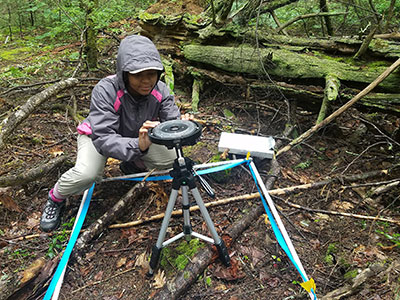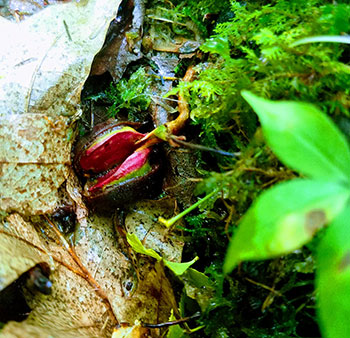You are here
What’s Out There?: A Small Yet Large Study of Harvard Forest
This summer I am working under Sydne Record and John Grady’s project on seedling dynamics. I chose this internship to get more of a feel for the ecological field that I was introduced to a few years ago, and to continue research in Sydne’s lab at my home institution.
 The aim of my project is to understand seedling population dynamics, with respect to abundance and growth rates, within Harvard Forest’s 35 hectre megaplot. Colleen (my research partner) and I have randomly set up fifty 1 m2 pvc plots across the megaplot, and have located, tagged and measured the height of all stems that have a diameter under 1 cm. In addition, we have measured diameters of certain species within and near our plot. Why 1 cm? Well, the megaplot was created in 2010 to start a long-term census of all trees over 1 cm. This 1 cm rule was likely done out of practicality, because the number of seedlings and trees that are under 1 cm are vastly greater than the number of established trees (greater than 1 cm). The survivorship of seedlings is typically greatly reduced compared to their established counterparts. Hence, seedlings have been previously deemed unnecessary for study due to their high mortality and abundance. The challenging highlights of this summer have been crawling through woody bush to reach potential plots and having daily battles with various insects. However, our data will be added to this previous dataset to understand more about forest composition, with this inclusion of data for more of the total forest population.
The aim of my project is to understand seedling population dynamics, with respect to abundance and growth rates, within Harvard Forest’s 35 hectre megaplot. Colleen (my research partner) and I have randomly set up fifty 1 m2 pvc plots across the megaplot, and have located, tagged and measured the height of all stems that have a diameter under 1 cm. In addition, we have measured diameters of certain species within and near our plot. Why 1 cm? Well, the megaplot was created in 2010 to start a long-term census of all trees over 1 cm. This 1 cm rule was likely done out of practicality, because the number of seedlings and trees that are under 1 cm are vastly greater than the number of established trees (greater than 1 cm). The survivorship of seedlings is typically greatly reduced compared to their established counterparts. Hence, seedlings have been previously deemed unnecessary for study due to their high mortality and abundance. The challenging highlights of this summer have been crawling through woody bush to reach potential plots and having daily battles with various insects. However, our data will be added to this previous dataset to understand more about forest composition, with this inclusion of data for more of the total forest population.
 Our goal for the project is to study the idea of energy equivalence. This hypothesis states that body size does not determine how much total energy is used across different size classes of individuals. This theory is interesting because it does not look at species specific differences, like herbivory vs carnivory. Body size relationships to energy use is the most important determining factor driving this hypothesis. How does one go about tackling such a theory? Well, we are measuring energy use as a function of growth, and will group our height and diameter data to create size classes for our communities. We are measuring the heights and diameters of our tagged seedlings for this initial census, and they will be measured again towards the end of the summer. This will allow us to understand how much energy these individuals are using. When the second set of measurements are collected, we will compare the energy use (growth rate) between our size classes.
Our goal for the project is to study the idea of energy equivalence. This hypothesis states that body size does not determine how much total energy is used across different size classes of individuals. This theory is interesting because it does not look at species specific differences, like herbivory vs carnivory. Body size relationships to energy use is the most important determining factor driving this hypothesis. How does one go about tackling such a theory? Well, we are measuring energy use as a function of growth, and will group our height and diameter data to create size classes for our communities. We are measuring the heights and diameters of our tagged seedlings for this initial census, and they will be measured again towards the end of the summer. This will allow us to understand how much energy these individuals are using. When the second set of measurements are collected, we will compare the energy use (growth rate) between our size classes.
 In addition to studying body size/energy use relationships, we are looking at how light availability plays a role in seedling abundance and total growth rate. As I said earlier, seedlings have significantly greater populations than older, established trees, however they reside on the forest floor, where light availability is greatly reduced. We are trying to understand how light availability/competition is impacting the growth of these seedlings. At the beginning of the summer, Colleen and I assessed various points within the megaplot for canopy openness, or otherwise the amount of light filtering through to the forest floor. At each spot, we looked at the canopy of the forest and used 4 categories to eyeball how much light was getting to the seedlings. We later went back to each location and used a hemispherical camera to further quantify the percent of canopy openness, which can be used to further defend our initial analysis. The light analysis and height measurements can help us determine how much seedlings are growing, and within various light conditions. My portion of the project will be focused on understanding energy equivalence further and connecting our growth and abundance data to the larger populations that have already been studied. This summer was my first field experience in a forest. I have previous collected data on coral reefs and seabirds off an island, so it has been interesting working with organisms a little closer to my everyday life.
In addition to studying body size/energy use relationships, we are looking at how light availability plays a role in seedling abundance and total growth rate. As I said earlier, seedlings have significantly greater populations than older, established trees, however they reside on the forest floor, where light availability is greatly reduced. We are trying to understand how light availability/competition is impacting the growth of these seedlings. At the beginning of the summer, Colleen and I assessed various points within the megaplot for canopy openness, or otherwise the amount of light filtering through to the forest floor. At each spot, we looked at the canopy of the forest and used 4 categories to eyeball how much light was getting to the seedlings. We later went back to each location and used a hemispherical camera to further quantify the percent of canopy openness, which can be used to further defend our initial analysis. The light analysis and height measurements can help us determine how much seedlings are growing, and within various light conditions. My portion of the project will be focused on understanding energy equivalence further and connecting our growth and abundance data to the larger populations that have already been studied. This summer was my first field experience in a forest. I have previous collected data on coral reefs and seabirds off an island, so it has been interesting working with organisms a little closer to my everyday life.
 Another interesting aspect of the summer has been discovering the various wildlife within the forest. We have seen things as small as red eft newts and as big as white-tailed deer, adding to the wonder and beauty of the forest, and the experience of the summer. I have also learned a great deal about the various plant life in the forest, like the tasty wild blueberries and beautiful striped maple. I plan on using this research and any further data for my senior thesis presentation in the spring.
Another interesting aspect of the summer has been discovering the various wildlife within the forest. We have seen things as small as red eft newts and as big as white-tailed deer, adding to the wonder and beauty of the forest, and the experience of the summer. I have also learned a great deal about the various plant life in the forest, like the tasty wild blueberries and beautiful striped maple. I plan on using this research and any further data for my senior thesis presentation in the spring.
Kalaina Thorne is a rising senior studying Biology at Bryn Mawr College. Her interests include mammalian wildlife and marine studies.

